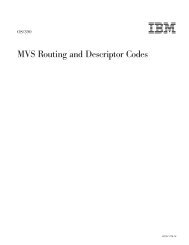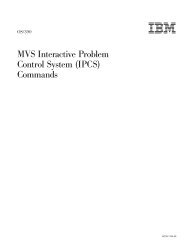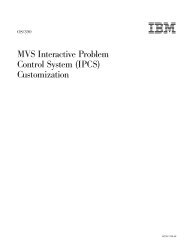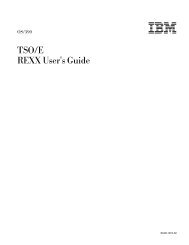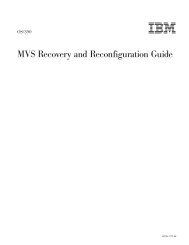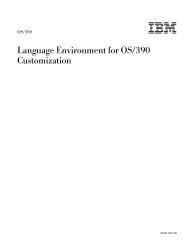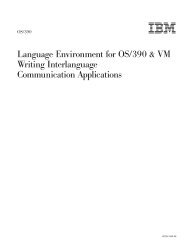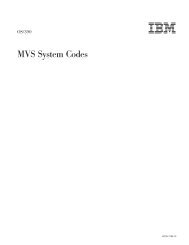OS/390 MVS IPCS User's Guid
OS/390 MVS IPCS User's Guid
OS/390 MVS IPCS User's Guid
You also want an ePaper? Increase the reach of your titles
YUMPU automatically turns print PDFs into web optimized ePapers that Google loves.
v<br />
v<br />
Unformatted information in virtual storage access method (VSAM) data sets or<br />
other types of data sets<br />
Active system storage for the <strong>IPCS</strong> user’s address space<br />
See <strong>OS</strong>/<strong>390</strong> <strong>MVS</strong> Diagnosis: Tools and Service Aids for more information about<br />
dumps and traces.<br />
When you first access a source, <strong>IPCS</strong> recognizes the type of data in the source<br />
and begins the appropriate type of processing.<br />
Dump Data Set Processing<br />
<strong>IPCS</strong> decides if the source data set should be treated as a system dump by<br />
comparing the data set to the following criteria:<br />
v<br />
v<br />
v<br />
The dump data must be stored on a data set with sequential (PS), direct (DA), or<br />
unidentified (*) organization.<br />
The logical record length (LRECL) must be 4160 bytes<br />
The data set must have one of the following combinations of record format<br />
(RECFM) and block size (BLKSIZE):<br />
RECFM=F,BLKSIZE=4160<br />
RECFM=FB,BLKSIZE=4160<br />
RECFM=FBS,BLKSIZE=n*4160 where n=1,2,...<br />
If the data set meets these criteria, <strong>IPCS</strong> provides dump processing, meaning that<br />
<strong>IPCS</strong> simulates system services, such as dynamic address translation and control<br />
block formatting, when processing the source.<br />
In systems with Data Facility Storage Management Subsystem/<strong>MVS</strong> (DFSMS/<strong>MVS</strong>),<br />
<strong>IPCS</strong> supports extended sequential data sets, which IBM recommends using.<br />
Extended sequential data sets:<br />
v Have a greater capacity than sequential data sets<br />
v Support striping<br />
v Support compression<br />
Some dump data sets are quite large compared with other data sets generated by a<br />
system. The capacity of an extended sequential data set is enough to hold the<br />
largest stand-alone dumps, as much as 128 gigabytes.<br />
Striping spreads sections, or stripes, of a data set across multiple volumes and<br />
uses independent paths, if available, to those volumes. The multiple volumes and<br />
independent paths accelerate sequential reading and writing of the data set,<br />
reducing the time during which dump and trace I/O competes with production I/O.<br />
In a striped data set, when the last volume receives a stripe, the next stripes are<br />
placed on the first volume, the second volume, the third, and so on to the last<br />
volume, then back to the first volume. If n volumes are used, striping allows<br />
sequential access to the data set at nearly n times the rate at which a single<br />
volume data set can be processed. The faster processing speeds up moving dump<br />
data from relatively expensive data space storage to less expensive DASD.<br />
Compression allows dump data sets to use less DASD space. Before using<br />
compression, consider the following:<br />
v<br />
Compression and decompression trade off processing cycles for more efficient<br />
use of DASD. If software compression is used because hardware compression is<br />
not available, the number of processing cycles is significantly higher and<br />
noticeably impacts response time.<br />
Chapter 1. Introduction to <strong>IPCS</strong> 5



